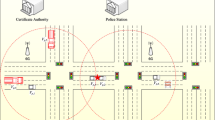Abstract
Emergency vehicle priority (EVP) systems are the need of the hour to reduce the transit time of emergency vehicles in cities. As these cities are major hubs of economic activity they are one of the most densely populated cities in the world. Due to numerous such issues, ambulances are not able to reach patients and hospitals on time. In this paper, we propose a system that detects an ambulance accurately and helps set up a makeshift emergency lane on the routes to be taken by it. The system relies on a neural network-based siren classifier to detect the ambulance using audio processing. The overall accuracy of the siren classifier was 97.2 %. After the ambulance is detected this information is then passed onto a network of Internet of Things (IoT) devices that activate visual indicators on the routes to be taken by the ambulance. On activating the visual indicators the traffic on those roads can start making a temporary emergency lane. The system uses a GPS-based mobile app to get route information of the ambulance. The network of IoT devices consists of a host device and station/node devices in a chain-like connection, where all devices are communicating via local WiFi networks. The host receives information about the ambulance from the neural network and the mobile app. The host then sends this information down the chain to other node devices. Through our proposed system we hope that the transit time of ambulances is reduced and hence accident victims, heart attack patients, etc can get medical attention faster.






Similar content being viewed by others
Code availability
All the codes have been made available in the supplementary material.
References
Beritelli, F., Casale, S., Russo, A., Serrano, S.: An automatic emergency signal recognition system for the hearing impaired. In: IEEE 12th Digital Signal Processing Workshop & 4th IEEE Signal Processing Education Workshop. IEEE 2006, pp. 179–182 (2006)
Bharadwaj, R., Deepak, J., Baranitharan, M., Vaidehi, V.: Efficient dynamic traffic control system using wireless sensor networks. In: 2013 International Conference on Recent Trends in Information Technology (ICRTIT). IEEE, pp. 668–673 (2013)
Brill, W.E.: Emergency vehicle detection system. uS Patent 6,362,749 (Mar. 26 2002)
Buchenscheit, A., Schaub, F., Kargl, F., Weber, M.: A vanet-based emergency vehicle warning system. In: IEEE Vehicular Networking Conference (VNC). IEEE 2009, pp. 1–8 (2009)
Bygrave, C., Dineen, O., Norton, P., Bell, D.R.: Early warning system for approaching emergency vehicles. uS Patent 7,515,065 (Apr. 7 2009)
Ellis, D.P.: Detecting alarm sounds (2001)
Eltayeb, A.S., Almubarak, H.O., Attia, T.A.: A gps based traffic light pre-emption control system for emergency vehicles. In: International Conference on Computing, Electrical and Electronic Engineering (ICCEEE). IEEE 2013, 724–729 (2013)
Emergency vehicle siren sounds, https://www.kaggle.com/vishnu0399/emergency-vehicle-siren-sounds
Huang, Y.-S., Weng, Y.-S., Zhou, M.: Design of traffic safety control systems for emergency vehicle preemption using timed petri nets. IEEE Transactions on Intelligent Transportation Systems 16(4), 2113–2120 (2015)
Kodire, V., Bhaskaran, S., Vishwas, H.: Gps and zigbee based traffic signal preemption. In: 2016 International Conference on Inventive Computation Technologies (ICICT), vol. 2, IEEE, pp. 1–5 (2016)
Louati, A., Elkosantini, S., Darmoul, S., Louati, H.: Multi-agent preemptive longest queue first system to manage the crossing of emergency vehicles at interrupted intersections. European Transport Research Review 10(2), 1–21 (2018)
Masoud, M., Belkasim, S.: Wsn-evp: A novel special purpose protocol for emergency vehicle preemption systems. IEEE Transactions on Vehicular Technology 67(4), 3695–3700 (2017)
Masum, A.K.M., Chy, M.K.A., Rahman, I., Uddin, M.N., Azam, K.I.: An internet of things (iot) based smart traffic management system: a context of bangladesh. In: 2018 International Conference on Innovations in Science, Engineering and Technology (ICISET). IEEE, pp. 418–422 (2018)
Mirchandani, P.B., Lucas, D.E.: Integrated transit priority and rail/emergency preemption in real-time traffic adaptive signal control. Journal of Intelligent Transportation Systems 8(2), 101–115 (2004)
Salamon, J., Jacoby, C., Bello, J.P.: A dataset and taxonomy for urban sound research. In: Proceedings of the 22nd ACM international conference on Multimedia, pp. 1041–1044 (2014)
Shaaban, K., Khan, M.A., Hamila, R., Ghanim, M.: A strategy for emergency vehicle preemption and route selection. Arabian Journal for Science and Engineering 44(10), 8905–8913 (2019)
Sharma, S., Pithora, A., Gupta, G., Goel, M., Sinha, M.: Traffic light priority control for emergency vehicle using rfid. Int. J. Innov. Eng. Technol 2(2), 363–366 (2013)
Shibuya, S., Yoshida, T., Yamashiro, Z., Miyawaki, M.: Fast emergency vehicle preemption systems. Transportation research record 1739(1), 44–50 (2000)
Sundar, R., Hebbar, S., Golla, V.: Implementing intelligent traffic control system for congestion control, ambulance clearance, and stolen vehicle detection. IEEE Sensors Journal 15(2), 1109–1113 (2014)
Tran, V..-T., Tsai, W..-H.: Acoustic-based emergency vehicle detection using convolutional neural networks. IEEE Access 8, 75 702-75 713 (2020)
Younes, M.B., Boukerche, A.: An efficient dynamic traffic light scheduling algorithm considering emergency vehicles for intelligent transportation systems. Wireless Networks 24(7), 2451–2463 (2018)
Acknowledgements
Authors would like to thank University of Mumbai for the funding and K. J. Somaiya College of Engineering for all the facilities and infrastructure provided.
Funding
Funding was received from University of Mumbai under Minor Research Project scheme ATD/ICD/2019-20/762, Project number:1070, Date:17 March, 2020.
Author information
Authors and Affiliations
Contributions
Conceptualization was done by R. Patel (RP), S. Mange (SM), S. R. Mulik (SRM), and N. Mehendale (NM). All the literature reading and data gathering were performed by RP, SM and SRM. All the experiments and coding was performed by RP, SM and SRM. The formal analysis was performed by RP. Manuscript writing original draft preparation was done by RP. Review and editing was done by NM. Visualization work was carried out by RP and NM.
Corresponding author
Ethics declarations
Conflict of interest
Authors R. Patel, S. Mange, S. Mulik and N. Mehendale declare that there has been no conflict of interest.
Ethics approval
All authors consciously assure that the manuscript fulfills the following statements: 1) This material is the authors’ own original work, which has not been previously published elsewhere. 2) The paper is not currently being considered for publication elsewhere. 3) The paper reflects the authors’own research and analysis in a truthful and complete manner. 4) The paper properly credits the meaningful contributions of co-authors and co-researchers. 5) The results are appropriately placed in the context of prior and existing research.
Consent to participate
This article does not contain any studies with animals or humans performed by any of the authors. Informed consent was not required as there were no human participants. All the necessary permissions were obtained from Institute Ethical committee and concerned authorities.
Consent for publication
Authors have taken all the necessary consents for publication from participants wherever required.
Supplementary Information
Below is the link to the electronic supplementary material.
Supplementary file1 (MP4 6156KB)
Supplementary file1 (MP4 47677)
Rights and permissions
About this article
Cite this article
Patel, R., Mange, S., Mulik, S. et al. AI based emergency vehicle priority system. CCF Trans. Pervasive Comp. Interact. 4, 285–297 (2022). https://doi.org/10.1007/s42486-022-00093-7
Received:
Accepted:
Published:
Issue Date:
DOI: https://doi.org/10.1007/s42486-022-00093-7




